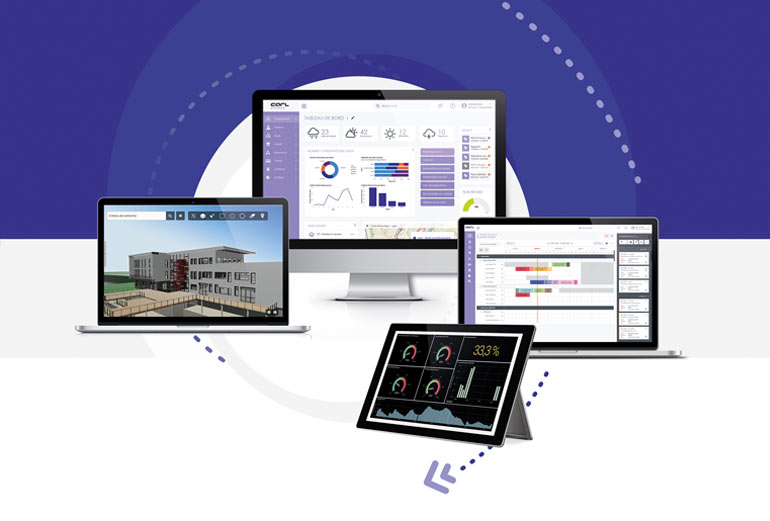CMMS for the transport sector: rolling stock maintenance
CMMS and transport: a matter of good timing
In the world of transport, the key is availability – availability of rolling stock and fixed installations to ensure service to users. Good service depends on good maintenance planning. CMMS is the driving force behind the availability of buses, streetcars, metros and other means of transport, and must guarantee it..
The key to maintenance: guaranteeing maximum rolling stock availability
“Literally and figuratively, we’ve got to keep things running,” confides Frédéric Boutier, Sales Manager at CARL Berger-Levrault.
The key to maintenance in the transport sector is to guarantee maximum availability of both rolling stock and fixed installations. It also means having the right vehicle for the right line (a bellows bus won’t run in right-angled alleys!).
On the other hand, poorly managed maintenance leads to heavy operating losses. CMMS is there to help operators manage their vehicles and infrastructures.
CMMS, for perfect knowledge of equipment and teams
It’s easy to see why: perfect knowledge of the equipment, as well as of the peaks and troughs of activity (so as to schedule workshop visits during the troughs), is crucial. However, whether we’re talking about trains, buses or streetcars, we’re talking about highly complex technical units whose maintenance requires skilled personnel, special workshops and tools, spare parts, and sometimes external service providers. That’s why, when we bring these road or rail vehicles into our workshops, we check them from every angle, mobilizing all the necessary teams.
Just as indispensable is the real-time relationship with the rolling stock operating teams. From the roof to the car body, from the passenger area to the driver’s cab, specialized personnel are assigned to each area of intervention, working in the pit (chassis, braking system), on the roof (electricity, air conditioning) or in the cab (seats, validators, wind vanes). Everything is centralized on the CMMS.
Orchestrating complexity with CMMS
This complexity can be broken down into sub-equipment, sub-organisms… right down to spare parts, characterized by a huge variety of technical part families, corresponding to different manufacturers and models. Given this profusion, a CMMS solution is essential to orchestrate all these resources and adapt to the vagaries of planning.
It also enables the tracking of technical documentation and statistical information relating to a breakdown for a given vehicle or model of vehicle (bus, streetcar, metro, etc.). Technicians can thus identify a problem and pass it on to the manufacturer, who can then integrate it into the manuals delivered with the purchase of a similar model, and into his own updates.
These detailed tree structures – one of the strengths of the CARL Source solution – make the CMMS a powerful tool for cross-referencing and excellence.
Three-quarters of rolling stock maintenance is internalized, entrusted to technicians with specific knowledge of their equipment, its maintenance and its vagaries. And then there’s the part that can only be entrusted to specialists. We send them the component to be repaired, while keeping a stock of what needs to be replaced during the repair. As the repaired component does not necessarily return to its original vehicle, we organize the interchangeability and standardization of important parts.
 Press Reviews : Berger-Levrault strengthens its presence in the transport sector with partner Elazur.
Press Reviews : Berger-Levrault strengthens its presence in the transport sector with partner Elazur.

The specific challenge of spare parts managed on the CMMS
Parts management is extremely sophisticated: if a part is missing on the day of “major maintenance”, the equipment is immobilized and the entire logistics chain is thrown out of kilter.
On the other hand, we make a point of not overstocking parts. There are too many bulky, expensive parts – or both – that we only want to order “just in time”, and whose delivery schedule has to be adhered to. There are also “dead stocks”, where parts that no longer fit any particular rolling stock gather dust. Nomenclature and inventory are the key to intelligent, optimized parts management, monitored by the CMMS.
Finally, the notion of serialization is important. A spare part is discarded, while a serialized part (bearing a serial number, like the chassis or engine of our cars) is replaced. You want to be able to track the part, because it’s expensive and includes or requires spare parts, and CMMS obviously offers this possibility.
CMMS, the cornerstone of intervention planning, regulatory monitoring of equipment…
Mainly related to safety, regulatory maintenance is scheduled in the CMMS; some solutions even offer automatic integration of regulatory inspection reports. Their traceability is essential in the event of a subsequent accident: we need to be able to show that the right maintenance actions were carried out by the right certified technician, and then approved by the right supervisor. CARL Source CMMS records these elements.
… and control of contractual commitments!
The constant challenge is to intervene at the right time to avoid breakdowns and meet contractual availability commitments!
For the transport company, public service delegation implies contractual obligations. It must deliver service quality indicators, the main criteria of which are availability (a well-maintained fleet guarantees 98% availability) and service interruption. It must also provide a means of comparing actual operating costs with contractual commitments. The CMMS solution produces the required reports, and inspires contractual readjustments where necessary
Mobile CMMS, a major asset for technicians
In the event of unforeseen circumstances, or as part of a preventive maintenance plan, the technician needs to intervene. Thanks to the CARL Touch mobile CMMS application, the technician is notified of any work to be carried out. He can geolocate the equipment, and wherever he is, he has access to the breakdown history, exploded views, technical diagrams and other tutorials for the equipment to be repaired – in short, all the knowledge he needs. He also takes the opportunity to check the causes of the bus breakdown. In fact, processes require the identification of the reasons for equipment stoppages, and the CMMS tool requires a report from both the driver and the technician involved.
CMMS continues to be the repository for user reports
For the local authority, user reports (breakdowns, vandalism, etc.) contribute to the efficiency of the maintenance department.
What better way to do this than with a service request application accessible to all passengers, which informs the technical department of a problem and triggers the intervention of the teams!
More and more often, participative tools appear in the specifications submitted to the CMMS operator. Users want to be able to report problems… and they expect feedback.
Before, we’d tell them there’d be a 2-hour delay; now we have to be able to tell them why!
Key benefits of CMMS for the transport sector :
- In-depth knowledge of the rolling stock fleet.
- Ensuring that equipment remains in operational condition and that users are safe.
- Orchestration of human resources and parts mobilized for maintenance.
- Predictive monitoring of breakdowns via sensors connected to equipment.
- Gathering and scheduling information for reporting to the decision-maker.
- Rapid response thanks to a mobile application that enables users to alert and operators to take action.
Our latest references in the Transport sector
Our CMMS solution for the transport sector: CARL Source Transport
CARL Source Transport is our CMMS solution dedicated to the transport sector. It has been designed to guarantee the best possible operating conditions for the resources at your disposal (rolling stock, fixed installations, linear assets). It enables you to structure your fleet, guarantee equipment availability, passenger and staff safety, monitor your activity in real time, optimize costs, and manage your contracts, while reconciling quality and budgetary control. Designed in partnership with major players in the industry, this solution will help you meet the new constraints of the transport sector.


